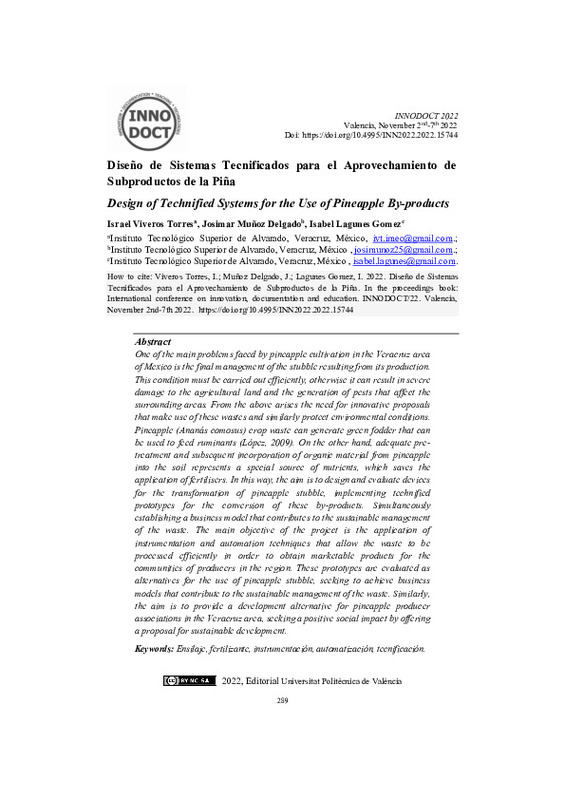JavaScript is disabled for your browser. Some features of this site may not work without it.
Buscar en RiuNet
Listar
Mi cuenta
Estadísticas
Ayuda RiuNet
Admin. UPV
Diseño de sistemas tecnificados para el aprovechamiento de subproductos de la piña
Mostrar el registro sencillo del ítem
Ficheros en el ítem
| dc.contributor.author | Viveros Torres, Israel
|
es_ES |
| dc.contributor.author | Muñoz Delgado, Josimar
|
es_ES |
| dc.contributor.author | Lagunes Gomez, Isabel
|
es_ES |
| dc.coverage.spatial | east=-96.1342241; north=19.173773; name=5VF8+G8 Veracruz, Estat de Veracruz, Mèxic | es_ES |
| dc.date.accessioned | 2023-05-22T07:20:08Z | |
| dc.date.available | 2023-05-22T07:20:08Z | |
| dc.date.issued | 2023-05-22T07:20:08Z | |
| dc.identifier.isbn | 9788413960364 | |
| dc.identifier.uri | http://hdl.handle.net/10251/193489 | |
| dc.description.abstract | [ES] Uno de los principales problemas que enfrenta el cultivo de la piña en la zona de Veracruz México, es el manejo final del rastrojo que resulta de su producción. Dicha condición debe ejecutarse eficazmente, de lo contrario, puede dar como resultado un daño severo al terreno agrícola y generación de plagas que afectan a las zonas circundantes. De lo anterior surge la necesidad de propuestas innovadoras que aprovechen estos desechos y proteger análogamente las condiciones medio ambientales. Los desechos del cultivo de la piña (Ananás comosus) pueden generar forraje verde que puede ser aprovechable en la alimentación de rumiantes. Por otra parte un adecuado pretratamiento y posterior incorporación del material orgánico de la piña al suelo representa una fuente de nutrientes especial, lo que permite ahorrar la aplicación de fertilizantes. De esta forma se busca diseñar y evaluar dispositivos de transformación del rastrojo de la piña, diseñandoe implementando prototipos tecnificados para la conversión de estos subproductos. Estableciendo de manera simultánea un modelo de negocio que contribuya con el manejo sostenible del residuo. El objetivo principal del proyecto es la aplicación de técnicas de instrumentación y automatización que permitan el procesamiento de los desechos de forma eficiente a fin de obtener productos comercializables para las comunidades de productores de la región. Estos prototipos se evalúan como alternativas de aprovechamiento del rastrojo de la piña, buscando lograr modelos de negocio que contribuyan al manejo sostenible del residuo, analogamente se busca ser una alternativa de desarrollo para las asociaciones de productores de piña de la zona de Veracruz, buscando un impacto social positivo al brindar una propuesta de desarrollo sustentable. | es_ES |
| dc.description.abstract | [EN] One of the main problems faced by pineapple cultivation in the Veracruz area of Mexico is the final management of the stubble resulting from its production. This condition must be carried out efficiently, otherwise it can result in severe damage to the agricultural land and the generation of pests that affect the surrounding areas. From the above arises the need for innovative proposals that make use of these wastes and similarly protect environmental conditions. Pineapple (Ananás comosus) crop waste can generate green fodder that can be used to feed ruminants (López, 2009). On the other hand, adequate pre-treatment and subsequent incorporation of organic material from pineapple into the soil represents a special source of nutrients, which saves the application of fertilisers. In this way, the aim is to design and evaluate devices for the transformation of pineapple stubble, implementing technified prototypes for the conversion of these by-products. Simultaneously establishing a business model that contributes to the sustainable management of the waste. The main objective of the project is the application of instrumentation and automation techniques that allow the waste to be processed efficiently in order to obtain marketable products for the communities of producers in the region. These prototypes are evaluated as alternatives for the use of pineapple stubble, seeking to achieve business models that contribute to the sustainable management of the waste. Similarly, the aim is to provide a development alternative for pineapple producer associations in the Veracruz area, seeking a positive social impact by offering a proposal for sustainable development. | es_ES |
| dc.format.extent | 9 | |
| dc.language | Español | es_ES |
| dc.publisher | Editorial Universitat Politècnica de València | es_ES |
| dc.relation.ispartof | Proceedings INNODOCT/22. International Conference on Innovation, Documentation and Education | |
| dc.rights | Reconocimiento - No comercial - Compartir igual (by-nc-sa) | es_ES |
| dc.subject | Piña (Ananás comosus) | es_ES |
| dc.subject | Aprovechamiento de residuos agroindustriales | es_ES |
| dc.subject | Veracruz (México) | es_ES |
| dc.subject | Cultivo de piña | es_ES |
| dc.subject | Ensilaje | es_ES |
| dc.subject | Fertilizantes | es_ES |
| dc.title | Diseño de sistemas tecnificados para el aprovechamiento de subproductos de la piña | es_ES |
| dc.type | Capítulo de libro | es_ES |
| dc.type | Comunicación en congreso | es_ES |
| dc.identifier.doi | 10.4995/INN2022.2022.15744 | |
| dc.rights.accessRights | Abierto | es_ES |
| dc.description.bibliographicCitation | Viveros Torres, I.; Muñoz Delgado, J.; Lagunes Gomez, I. (2023). Diseño de sistemas tecnificados para el aprovechamiento de subproductos de la piña. En Proceedings INNODOCT/22. International Conference on Innovation, Documentation and Education. Editorial Universitat Politècnica de València. 289-297. https://doi.org/10.4995/INN2022.2022.15744 | es_ES |
| dc.description.accrualMethod | OCS | es_ES |
| dc.relation.conferencename | INNODOCT 2022 | es_ES |
| dc.relation.conferencedate | Noviembre 02-07, 2022 | es_ES |
| dc.relation.conferenceplace | Valencia, España | es_ES |
| dc.relation.publisherversion | http://ocs.editorial.upv.es/index.php/INNODOCT/INN2022/paper/view/15744 | es_ES |
| dc.description.upvformatpinicio | 289 | es_ES |
| dc.description.upvformatpfin | 297 | es_ES |
| dc.type.version | info:eu-repo/semantics/publishedVersion | es_ES |
| dc.relation.pasarela | OCS\15744 | es_ES |
| dc.contributor.funder | instituto tecnológico superior de Alvarado | es_ES |








